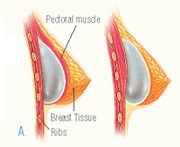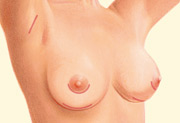Augmentation Mammaplasty
Breast augmentation is a surgical procedure that enhances the size and shape of the breasts. The indications for breast augmentation are small or asymmetrical breasts. The procedure is accomplished by the insertion of saline- or silicone gel-filled implants behind the breasts. Placement may be either directly under the breast tissue or beneath the chest wall muscle. At your consultation, we will discuss which option is best for you. Surgery is usually performed in an outpatient setting with the patient under general anesthesia. The procedure typically lasts about two hours. Breast augmentation may be combined with breast lift and, if so, the total surgery will take longer.
After surgery, you will probably experience some soreness, swelling and bruising. The nipple and/or other areas of the breast may have temporarily altered sensation, and the operated breast may be sensitive to touch.
Risks include capsular contracture, which may require surgery to release the scar, and/or removal of the implant. Implant rupture will result in implant removal and/or replacement. Other risks are bleeding, infection, malpositioning, skin rippling secondary to the use of the saline-filled implant and permanently altered sensation in the nipple and/or other areas of the breast.
You can go back to work and resume some activities within a few days to one week, but breasts will be sensitive to touch for several weeks. Scars will fade over time, but never disappear entirely.
The duration of improvement is variable, and implants may have to be removed or replaced in a number of years. Women considering breast augmentation should be aware that special techniques are necessary to get a reliable mammogram of a breast with an implant, and experienced technicians are not available at all mammography facilities. Ultrasounds and MRIs may help to detect breast lumps or evaluate the status of an implant.
Procedural Steps
First, Anesthesia is induced
Medications are administered for your comfort during the surgical procedure. This procedure is usually done under general anesthesia
The incision
Incisions are made in inconspicuous areas to minimize visible scarring. At your consultation, we will discuss which incision options are appropriate for your desired outcome. Incision options include:

Incisions vary based on the type of breast implant, degree of enlargement desired, your particular anatomy and patient-surgeon preference.
Many patients inquire about the umbilical incision to place breast implants (belly button approach) which is often advertized. I do not recommend this approach for a variety of reasons. I do not feel that implant placement is as accurate by this approach which could lead to breast asymmetries. Also, the implant manufacturers feel that this approach puts a significant amount of stress on the implants. The following are direct quotes from product inserts of various breast implants:
“The periumbilical approach has not been studied in Mentor’s MemoryGel™ Breast Implant Core
Study and should not be used for a wide variety of reasons, including potential damage to the
implant shell.” - Source
“Use of endoscopic instruments or the periumbilical approach for placement of the implant has
not been studied in the Allergan clinical trial and is not recommended as damage to the device
may occur.” - Source
“The periumbilical approach has not been studied in the NATRELLER Core Study and
should not be used for a wide variety of reasons, including potential damage to the
implant shell.” - Source
“Do not use the periumbilical approach to place the implant.”

Placement of the breast implant
After the incision is made, a breast implant pocket is created either:
- Under the pectoral muscle (a submuscular placement), or
- Directly behind the breast tissue, over the pectoral muscle (a submammary/subglandular placement)
For all breast augmentations, I first introduce a sizer which allows me to assess the positioning and determine which size implant to use based on the patients preference. We then place either a silicone or saline implant.
Implant Choices
Saline breast implants
Are filled with sterile salt water. Should the implant shell leak, a saline implant will collapse and the saline will be absorbed and naturally expelled by the body.
Saline breast implants provide a uniform shape, firmness and feel, and are FDA-approved for augmentation in women age 18 or older.
Silicone breast implants
Are filled with silicone gel. The gel feels a bit more like natural breast tissue. If the implant leaks, the gel may remain within the implant shell, or may escape into the breast implant pocket. A leaking implant filled with silicone gel will not collapse.
If you choose silicone implants, you may need to visit your plastic surgeon regularly to make sure the implants are functioning properly. An ultrasound or MRI screening can assess the condition of breast implants.
Silicone breast implants are FDA-approved for augmentation in women age 22 or older.
Form-stable implants
Are sometimes referred to as gummy bear breast implants because they maintain their shape even when the implant shell is broken.
The consistency of the silicone gel inside the implant is thicker than traditional silicone gel implants. These implants are also firmer than traditional implants, but are thought to be less likely to break.
Gummy bear breast implants are shaped rather than round. They have more projection at the bottom and are tapered towards the top. If a shaped implant rotates, it may lead to an unusual appearance of the breast.
Placement of gummy bear implants requires a longer incision in the skin.
Closing the incisions
Incisions are closed with layered sutures in the breast tissue and with sutures, skin adhesive or surgical tape to close the skin.

Over time the incision lines will fade.
Breast augmentation recovery
During your breast augmentation recovery, you will be taken into a recovery area to be closely monitored following surgery.
You will have a support bra that will minimize swelling and support the breasts as they heal.
You may be permitted to go home after a few hours.
Before leaving, you will be given specific instructions that may include how to care for your breasts following surgery, medications to apply or take orally to aid healing and reduce the risk of infection, and when to follow-up in the office.
You may be instructed to wear a support bra around the clock for the first week or two.
After a post-surgical breast augmentation recovery period of 24 to 48 hours and an additional reduced-activity period of a few days, you will likely experience soreness and swelling for a few weeks.
Exercise and normal activity can resume at the direction of your plastic surgeon.
Breast augmentation risks and safety
The decision to have plastic surgery is extremely personal and you will have to decide if the benefits will achieve your goals and if the risks and potential complications of breast augmentation are acceptable.
You will be asked to sign consent forms to ensure that you fully understand the procedure and any risks and potential complications.
Possible breast augmentation surgery risks include:
- Anesthesia risks
- Bleeding
- Infection
- Changes in nipple or breast sensation
- Poor scarring of skin
- Wrong or faulty position of the implant
- Implant leakage or rupture
- The formation of tight scar tissue around the implant (capsular contracture)
- Fluid accumulation (seroma)
- Wrinkling of the skin over the implant
- Pain, which may persist
- Possibility of revisional surgery
These risks and others will be fully discussed prior to your consent. It is important that you address all your questions prior to surgery
Breast implant safety
Breast implants do not impair breast health.
Careful reviews of scientific research by independent groups such as the Institute of Medicine have found no link between breast implants and autoimmune or other systemic diseases.
Other important considerations:
- Breast implants are not guaranteed to last a lifetime and future surgery may be required to replace one or both implants
- Pregnancy, weight loss, and menopause may influence the appearance of augmented breasts over the course of your lifetime
- Breast augmentation requires regular examinations of your breasts’ health and to evaluate the condition of your breast implants